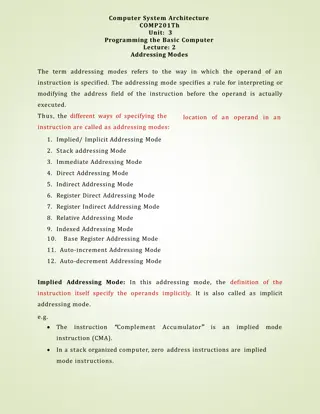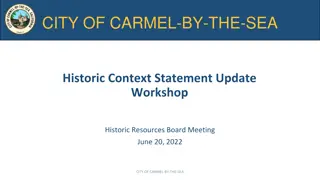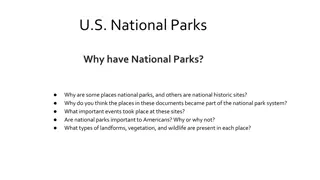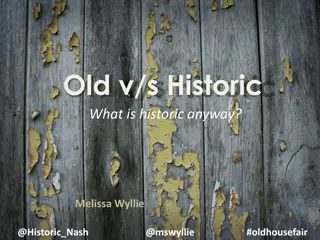Understanding the National Register of Historic Places
The National Register of Historic Places is maintained by the National Park Service and includes significant districts, sites, buildings, structures, and objects in American history, architecture, archaeology, engineering, and culture. Properties are added through various processes, and listing does not restrict property owners from taking actions but makes them eligible for Federal grants-in-aid for preservation.
Uploaded on Oct 07, 2024 | 0 Views
Download Presentation

Please find below an Image/Link to download the presentation.
The content on the website is provided AS IS for your information and personal use only. It may not be sold, licensed, or shared on other websites without obtaining consent from the author. Download presentation by click this link. If you encounter any issues during the download, it is possible that the publisher has removed the file from their server.
E N D
Presentation Transcript
National Historic Preservation Act The National Register of Historic Places
Analysis of Sec. 106 Definitions: National Register Undertaking Advisory Council State Historic Preservation Officer Tribal Historic Preservation Officer
National Register National Register of Historic Places Maintained by the Keeper, at the NPS Regulations at 36 CFR part 60 .included in or eligible for inclusion in the National Register The Secretary of the Interior is authorized to expand and maintain a National Register of Historic places composed of districts, sites, buildings, structures, and objects significant in American history, architecture, archaeology, engineering, and culture ( 101(a)(1)(A))
National Register Regulations 36CFR Part 60 (b) Properties are added to the National Register through the following processes. (1) Those Acts of Congress and Executive orders which create historic areas of the National Park System administered by the National Park Service, all or portions of which may be determined to be of historic significance consistent with the intent of Congress; (2) Properties declared by the Secretary of the Interior to be of national significance and designated as National Historic Landmarks; (3) Nominations prepared under approved State Historic Preservation Programs, submitted by the State Historic Preservation Officer and approved by the NPS; (4) Nominations from any person or local government (only if such property is located in a State with no approved State Historic Preservation Program) approved by the NPS and; (5) Nominations of Federal properties prepared by Federal agencies, submitted by the Federal Preservation Officer and approved by NPS.
Effect of Listing Listing of private property on the National Register does not prohibit under Federal law or regulation any actions which may otherwise be taken by the property owner with respect to the property. Listing in the National Register also makes property owners eligible to be considered for Federal grants-in-aid for historic preservation. 36CFR Part 60.2
National Register Criteria for Evaluation The quality of significance in American history, architecture, archaeology, engineering, and culture is present in districts, sites, buildings, structures, and objects that possess integrity of location, design, setting, materials, workmanship, feeling and association, and: A. That are associated with events that have made a significant contribution to the broad patterns of our history; or B. That are associated with the lives of persons significant in our past; or C. That embody the distinctive characteristics of a type, period, or method of construction, or that represent the work of master, or that possess high artistic values, or that represent a significant and distinguishable entity whose components may lack individual distinction; or D. That have yielded, or may be likely to yield, information important in prehistory or history.
What kinds of things? Types of things: Districts: A district is a geographically definable area, urban or rural, possessing a significant concentration, linkage, or continuity of sites, buildings, structures, or objects united by past events or aesthetically by plan or physical development. A district may also comprise individual elements separated geographically but linked by association or history. Sites: A site is the location of a significant event, a prehistoric or historic occupation or activity, or a building or structure, whether standing, ruined, or vanished, where the location itself maintains historical or archeological value regardless of the value of any existing structure. Buildings: A building is a structure created to shelter any form of human activity, such as a house, barn, church, hotel, or similar structure. Building may refer to a historically related complex such as a courthouse and jail or a house and barn. Structures: A structure is a work made up of interdependent and interrelated parts in a definite pattern of organization. Constructed by man, it is often an engineering project large in scale. Objects: An object is a material thing of functional, aesthetic, cultural, historical or scientific value that may be, by nature or design, movable yet related to a specific setting or environment. Traditional cultural places (TCPs)
Integrity? Integrity is a prerequisite for significance Integrity of: Location Design Setting Materials Workmanship Feeling, AND Association Doesn t really mean the same thing for an archaeological site and for a building or structure Register recognizes that these are different Integrity for Criterion D means that it can still yield the information
Criteria A = events B = persons C = styles D = data Archaeological sites can be eligible under any of these, but are most often eligible under D. With reason, Indian tribes sometimes complain about this.
Criteria considerations Ordinarily cemeteries, birthplaces or graves of historical figures, properties owned by religious institutions or used for religious purposes, structures that have been moved from their original locations, reconstructed historic buildings, properties primarily commemorative in nature, and properties that have achieved significance within the past 50 years shall not be considered eligible for the National Register. However . There are also 7 exceptions to the criteria considerations
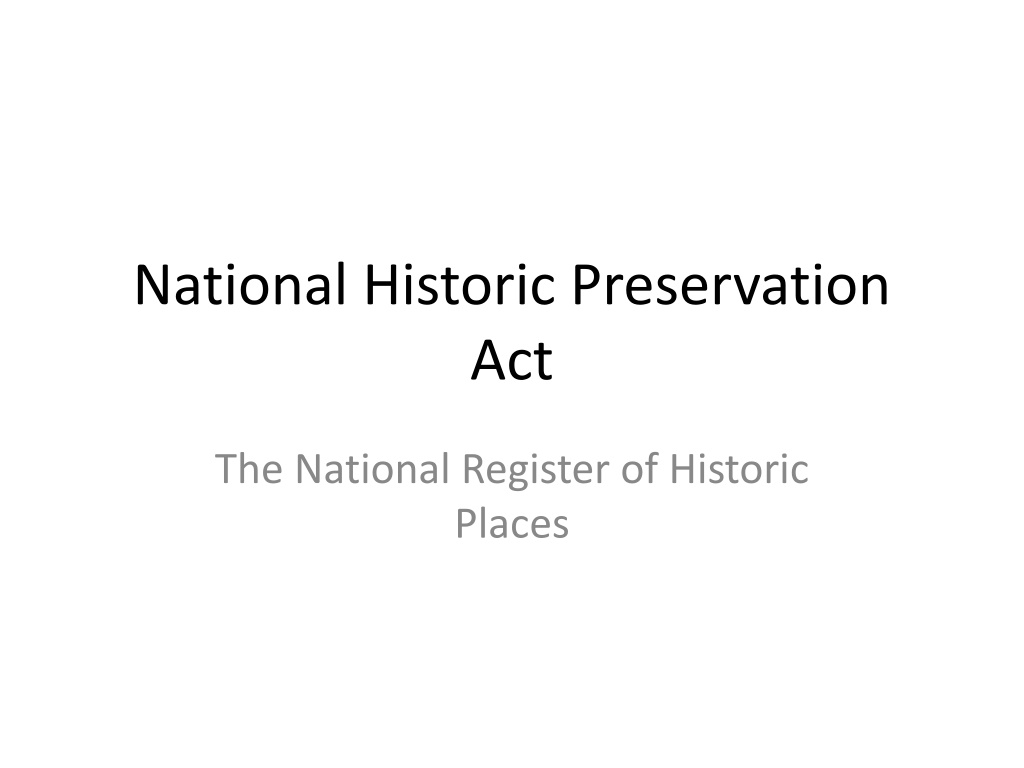



![❤[PDF]⚡ Apollo Mission Control: The Making of a National Historic Landmark (Spr](/thumb/21551/pdf-apollo-mission-control-the-making-of-a-national-historic-landmark-spr.jpg)





